Samuel Weinbach
u-$μ$P: The Unit-Scaled Maximal Update Parametrization
Jul 24, 2024Abstract:The Maximal Update Parametrization ($\mu$P) aims to make the optimal hyperparameters (HPs) of a model independent of its size, allowing them to be swept using a cheap proxy model rather than the full-size target model. We present a new scheme, u-$\mu$P, which improves upon $\mu$P by combining it with Unit Scaling, a method for designing models that makes them easy to train in low-precision. The two techniques have a natural affinity: $\mu$P ensures that the scale of activations is independent of model size, and Unit Scaling ensures that activations, weights and gradients begin training with a scale of one. This synthesis opens the door to a simpler scheme, whose default values are near-optimal. This in turn facilitates a more efficient sweeping strategy, with u-$\mu$P models reaching a lower loss than comparable $\mu$P models and working out-of-the-box in FP8.
T-FREE: Tokenizer-Free Generative LLMs via Sparse Representations for Memory-Efficient Embeddings
Jun 27, 2024



Abstract:Tokenizers are crucial for encoding information in Large Language Models, but their development has recently stagnated, and they contain inherent weaknesses. Major limitations include computational overhead, ineffective vocabulary use, and unnecessarily large embedding and head layers. Additionally, their performance is biased towards a reference corpus, leading to reduced effectiveness for underrepresented languages. To remedy these issues, we propose T-FREE, which directly embeds words through sparse activation patterns over character triplets, and does not require a reference corpus. T-FREE inherently exploits morphological similarities and allows for strong compression of embedding layers. In our exhaustive experimental evaluation, we achieve competitive downstream performance with a parameter reduction of more than 85% on these layers. Further, T-FREE shows significant improvements in cross-lingual transfer learning.
Efficient Parallelization Layouts for Large-Scale Distributed Model Training
Nov 09, 2023Abstract:Efficiently training large language models requires parallelizing across hundreds of hardware accelerators and invoking various compute and memory optimizations. When combined, many of these strategies have complex interactions regarding the final training efficiency. Prior work tackling this problem did not have access to the latest set of optimizations, such as FlashAttention or sequence parallelism. In this work, we conduct a comprehensive ablation study of possible training configurations for large language models. We distill this large study into several key recommendations for the most efficient training. For instance, we find that using a micro-batch size of 1 usually enables the most efficient training layouts. Larger micro-batch sizes necessitate activation checkpointing or higher degrees of model parallelism and also lead to larger pipeline bubbles. Our most efficient configurations enable us to achieve state-of-the-art training efficiency results over a range of model sizes, most notably a Model FLOPs utilization of 70.5% when training a 13B model.
Tokenizer Choice For LLM Training: Negligible or Crucial?
Oct 18, 2023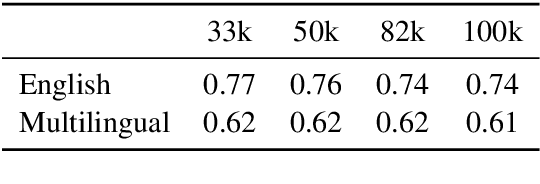
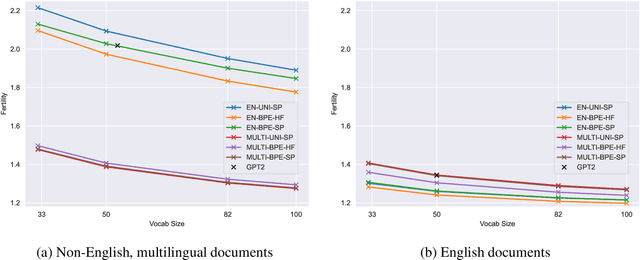
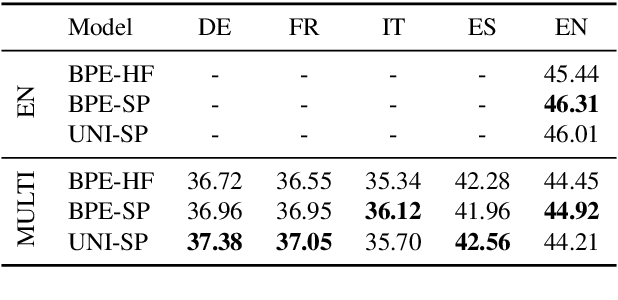
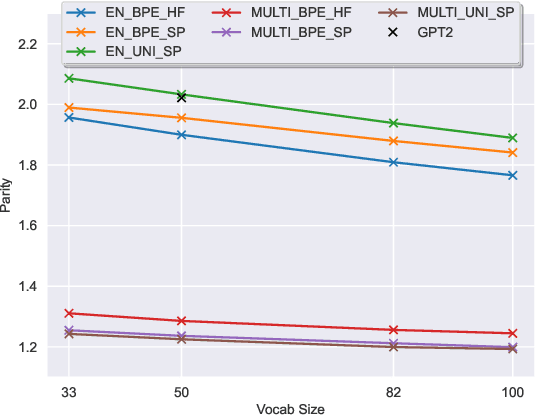
Abstract:The recent success of LLMs has been predominantly driven by curating the training dataset composition, scaling of model architectures and dataset sizes and advancements in pretraining objectives, leaving tokenizer influence as a blind spot. Shedding light on this underexplored area, we conduct a comprehensive study on the influence of tokenizer choice on LLM downstream performance by training 24 mono- and multilingual LLMs at a 2.6B parameter scale, ablating different tokenizer algorithms and parameterizations. Our studies highlight that the tokenizer choice can significantly impact the model's downstream performance, training and inference costs. In particular, we find that the common tokenizer evaluation metrics fertility and parity are not always predictive of model downstream performance, rendering these metrics a questionable proxy for the model's downstream performance. Furthermore, we show that multilingual tokenizers trained on the five most frequent European languages require vocabulary size increases of factor three in comparison to English. While English-only tokenizers have been applied to the training of multi-lingual LLMs, we find that this approach results in a severe downstream performance degradation and additional training costs of up to 68%, due to an inefficient tokenization vocabulary.
MultiFusion: Fusing Pre-Trained Models for Multi-Lingual, Multi-Modal Image Generation
May 24, 2023Abstract:The recent popularity of text-to-image diffusion models (DM) can largely be attributed to the intuitive interface they provide to users. The intended generation can be expressed in natural language, with the model producing faithful interpretations of text prompts. However, expressing complex or nuanced ideas in text alone can be difficult. To ease image generation, we propose MultiFusion that allows one to express complex and nuanced concepts with arbitrarily interleaved inputs of multiple modalities and languages. MutliFusion leverages pre-trained models and aligns them for integration into a cohesive system, thereby avoiding the need for extensive training from scratch. Our experimental results demonstrate the efficient transfer of capabilities from individual modules to the downstream model. Specifically, the fusion of all independent components allows the image generation module to utilize multilingual, interleaved multimodal inputs despite being trained solely on monomodal data in a single language.
AtMan: Understanding Transformer Predictions Through Memory Efficient Attention Manipulation
Jan 23, 2023Abstract:Generative transformer models have become increasingly complex, with large numbers of parameters and the ability to process multiple input modalities. Current methods for explaining their predictions are resource-intensive. Most crucially, they require prohibitively large amounts of extra memory, since they rely on backpropagation which allocates almost twice as much GPU memory as the forward pass. This makes it difficult, if not impossible, to use them in production. We present AtMan that provides explanations of generative transformer models at almost no extra cost. Specifically, AtMan is a modality-agnostic perturbation method that manipulates the attention mechanisms of transformers to produce relevance maps for the input with respect to the output prediction. Instead of using backpropagation, AtMan applies a parallelizable token-based search method based on cosine similarity neighborhood in the embedding space. Our exhaustive experiments on text and image-text benchmarks demonstrate that AtMan outperforms current state-of-the-art gradient-based methods on several metrics while being computationally efficient. As such, AtMan is suitable for use in large model inference deployments.
M-VADER: A Model for Diffusion with Multimodal Context
Dec 07, 2022Abstract:We introduce M-VADER: a diffusion model (DM) for image generation where the output can be specified using arbitrary combinations of images and text. We show how M-VADER enables the generation of images specified using combinations of image and text, and combinations of multiple images. Previously, a number of successful DM image generation algorithms have been introduced that make it possible to specify the output image using a text prompt. Inspired by the success of those models, and led by the notion that language was already developed to describe the elements of visual contexts that humans find most important, we introduce an embedding model closely related to a vision-language model. Specifically, we introduce the embedding model S-MAGMA: a 13 billion parameter multimodal decoder combining components from an autoregressive vision-language model MAGMA and biases finetuned for semantic search.
GPT-NeoX-20B: An Open-Source Autoregressive Language Model
Apr 14, 2022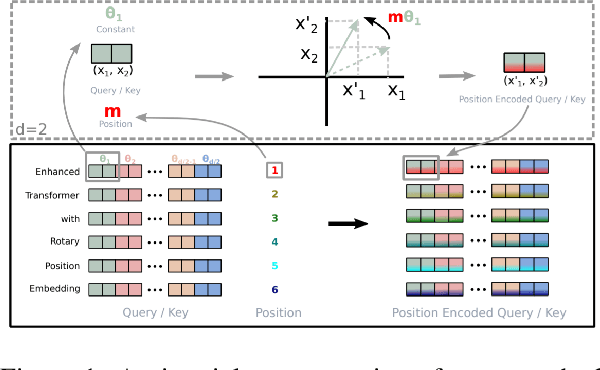
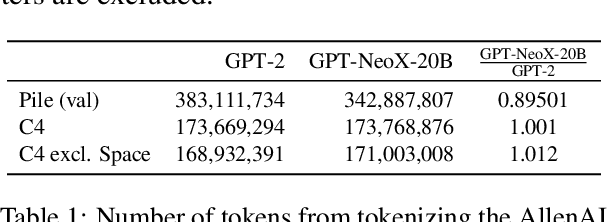
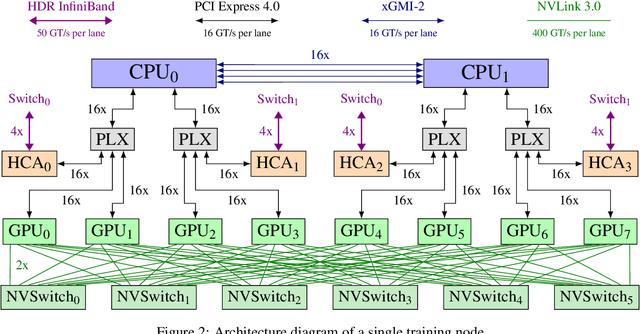
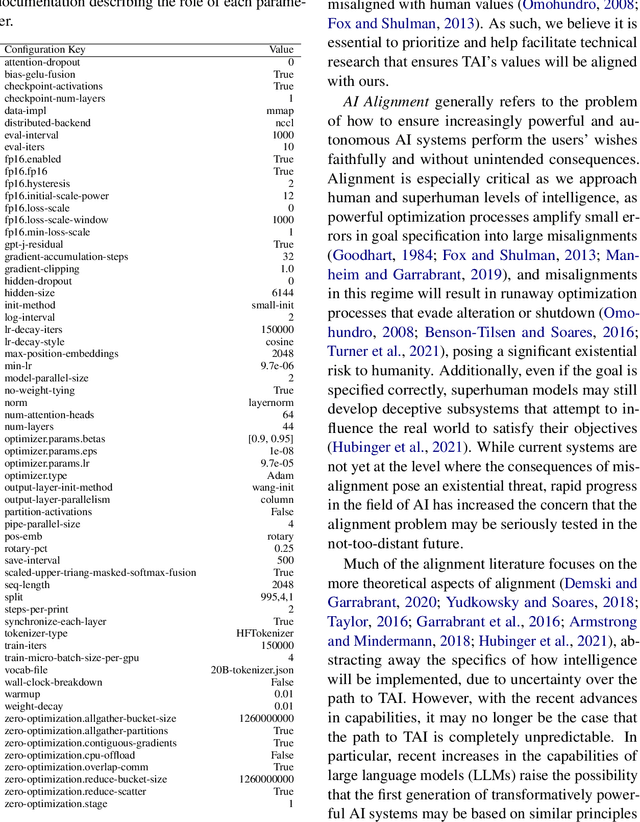
Abstract:We introduce GPT-NeoX-20B, a 20 billion parameter autoregressive language model trained on the Pile, whose weights will be made freely and openly available to the public through a permissive license. It is, to the best of our knowledge, the largest dense autoregressive model that has publicly available weights at the time of submission. In this work, we describe \model{}'s architecture and training and evaluate its performance on a range of language-understanding, mathematics, and knowledge-based tasks. We find that GPT-NeoX-20B is a particularly powerful few-shot reasoner and gains far more in performance when evaluated five-shot than similarly sized GPT-3 and FairSeq models. We open-source the training and evaluation code, as well as the model weights, at https://github.com/EleutherAI/gpt-neox.
MAGMA -- Multimodal Augmentation of Generative Models through Adapter-based Finetuning
Dec 09, 2021
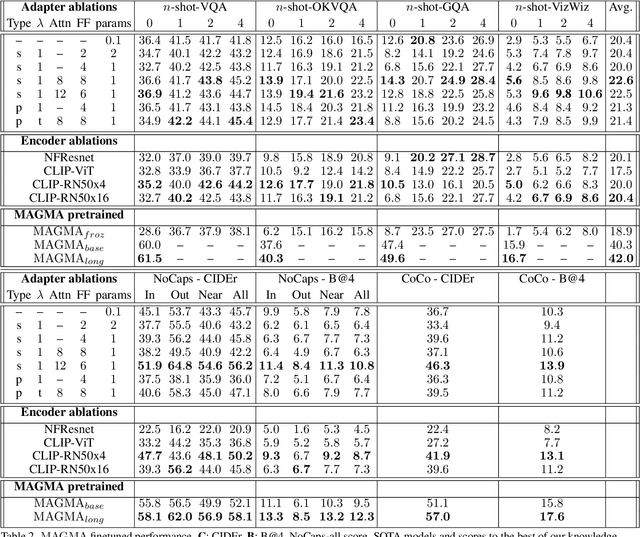
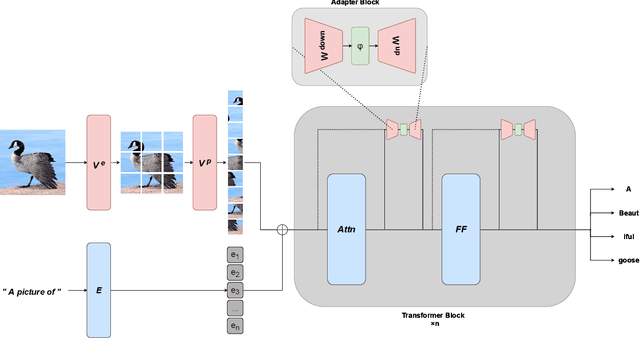

Abstract:Large-scale pretraining is fast becoming the norm in Vision-Language (VL) modeling. However, prevailing VL approaches are limited by the requirement for labeled data and the use of complex multi-step pretraining objectives. We present MAGMA - a simple method for augmenting generative language models with additional modalities using adapter-based finetuning. Building on Frozen, we train a series of VL models that autoregressively generate text from arbitrary combinations of visual and textual input. The pretraining is entirely end-to-end using a single language modeling objective, simplifying optimization compared to previous approaches. Importantly, the language model weights remain unchanged during training, allowing for transfer of encyclopedic knowledge and in-context learning abilities from language pretraining. MAGMA outperforms Frozen on open-ended generative tasks, achieving state of the art results on the OKVQA benchmark and competitive results on a range of other popular VL benchmarks, while pretraining on 0.2% of the number of samples used to train SimVLM.
Domain-Level Explainability -- A Challenge for Creating Trust in Superhuman AI Strategies
Nov 12, 2020

Abstract:For strategic problems, intelligent systems based on Deep Reinforcement Learning (DRL) have demonstrated an impressive ability to learn advanced solutions that can go far beyond human capabilities, especially when dealing with complex scenarios. While this creates new opportunities for the development of intelligent assistance systems with groundbreaking functionalities, applying this technology to real-world problems carries significant risks and therefore requires trust in their transparency and reliability. With superhuman strategies being non-intuitive and complex by definition and real-world scenarios prohibiting a reliable performance evaluation, the key components for trust in these systems are difficult to achieve. Explainable AI (XAI) has successfully increased transparency for modern AI systems through a variety of measures, however, XAI research has not yet provided approaches enabling domain level insights for expert users in strategic situations. In this paper, we discuss the existence of superhuman DRL-based strategies, their properties, the requirements and challenges for transforming them into real-world environments, and the implications for trust through explainability as a key technology.
 Add to Chrome
Add to Chrome Add to Firefox
Add to Firefox Add to Edge
Add to Edge